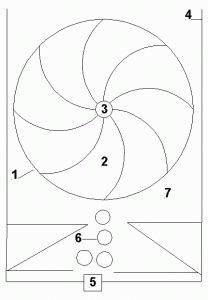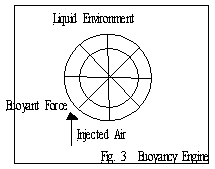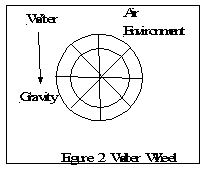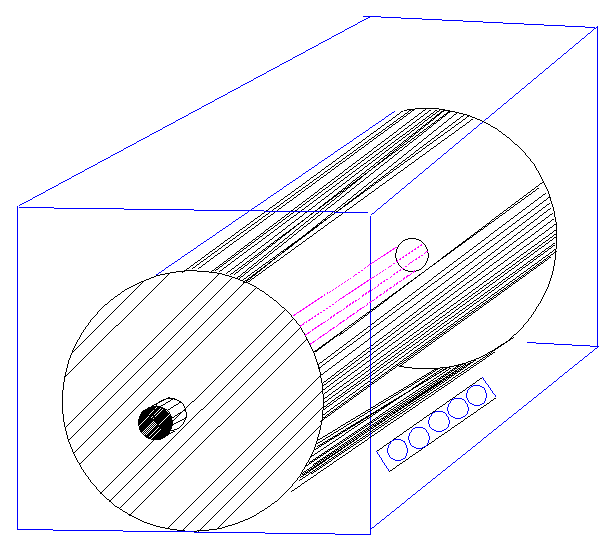The Production of Electricity by a Generator Driven by a Buoyancy engine
Working Title: Buoyant Power
My name is denis alan de Shon; I’m a researcher for Advanced Consulting Group in Baton Rouge, Louisiana.
I had been researching the works of Archimedes of Syracuse and other Greek Natural Philosophers when I saw a means for employing Archimedes’ findings in an engine to produce electricity,
This is accomplished by the introduction of excess pressurized gases from industry, both compressed air as well as compressed petroleum gases, into a buoyancy engine which turns a generator to produce electricity from the latent power in relatively low power compressed gases.
Here’s a brief History of Buoyancy.
Archimedes of Syracuse was a Genius Greek Mathematician and Natural Philosopher.
Recall, he’s the one who jumped out of his tub at the Syracuse Baths and ran naked toward his home shouting “Eureka, Eureka” (I Have Found).
In his bath, he realized that the mass of his body disposed in the tub displaced a certain amount of water.
By analogy, he discovered that the King’s Crown, which was alloyed with a material less dense than gold, displaced more water than the King’s other Crown of solid gold.
Thus he had solved the Kings Question “Has the Goldsmith replaced part of the Gold with Silver?”
Archimedes was a Builder of Engines. In Egypt, he perfected his Water Screw (Water Snail), a corkscrew device that, by rotation of the screw, moved the water from the bottom to the top.
He sold these to the Egyptians as a means for getting water out of the Nile and into the fields.
He built Grappling Hooks with Ropes and Compound Pulleys to lift ships out of the water.
He employed the Lever, where one traded distance for force, in building Catapults with ropes and pulleys for the defense of Syracuse against the Romans.
He is quoted as saying:
“Using a Lever, With a Given Force, it is Possible to Move any Given Weight. ”
and
“Give me a Place to Stand and I can Move the Earth.”
He also did a lot of mathematical work on Centers of Gravity. His work went into Center of Gravity for a Paraboloid, the Volume of a Sphere, Parabolic Mechanics, the Archimedean Spiral, Conic Sections and the Geometry of a Parabola.
His work with a Floating Parabola led to:
Archimedes’ Principle;
A Body Immersed in a Fluid is Buoyed up by a force that is equal to the Weight of the Fluid Displaced. 1
Archimedes’ treatise, On Floating Bodies, Proposition 6:
If a solid lighter than the fluid be forcibly immersed in it, the solid will be driven upwards by a force equal to the difference between its weight and the weight of the fluid displaced. 2
In the employment of Archimedes’ Principle, I have developed what I call:
de Shon’s Corollary to Archimedes’ Principle;

- Wheel
- Gas-Holding Spaces
- Axle
- Vessel Wall
- Gas Injector
- Gas Bubbles
- Liquid
An engine may be constructed which utilizes the Buoyant Force latent in compressed gases to produce power through the ascent of industrial surplus gas within a Buoyancy engine disposed in a liquid environment.
The gases displace the water in the gas holding spaces and become the “Body” in Archimedes’ Principle.
The gases are introduced at the 180 degree position of the gas-holding spaces, which are filled sequentially by the gas injector. The gases displace the water in the gas-holding spaces of the wheel.
These ascend due to the buoyancy of the gases in them, imparting a rotational force to the axle. Gases exit at the 360 degree position.
The engine rotates the axle, which turns a generator and produces electricity.
Here’s a contrast between Gravity Engines and Buoyancy Engines
A Gravity Engine, such as a Waterwheel, Fig. 2, uses the Force of Gravity.
Water is captured in the Water Holding Spaces of the Wheel, and Gravity drags the water downward in the Wheel imparting rotational force to the axle.
Buoyancy Engine, such as shown in Fig. 3, uses the Force of Buoyancy.
Surplus Industrial Compressed Gas or Petroleum gases are injected into the engine and are captured in the Gas-holding spaces of the Wheel.
The Buoyant Force drags the air upward in the Wheel, imparting rotational force to the axle.
Here’s a Computation of Gravitational/Buoyant Force:
The Force of Rotation in Gravity Engines is dependent on the Volume of Water introduced into the Wheel.
A cubic meter of water weighs 2,200 pounds, and provides that amount of Gravity Force.
The Force of Rotation in Buoyancy Engines is dependent on the Volume of Water displaced by the surplus industrial compressed gas, which is injected into it.
One cubic meter of Gas displaces one cubic meter of Water, weighing 2,200 pounds, and provides that amount of Buoyant Lift.
Buoyant Power is low tech power. It can be used anywhere, with a minimum of technology.
The Wheel can be of extruded plastic, and can be shipped economically.
Not a lot of technical skill is required to assemble the wheel on a shaft, attach a generator, and mount in a tank near a source of surplus compressed gas of at least 15psig.
The liquid in the tank can be altered to suit scrubbing needs for EPA standards, if the compressed gas is a schedule item.
Several levels of Buoyancy Engines may be stacked, one on top of the other in a taller tank, in cases where there is a space constraint or to take advantage of the re-use of high pressure inputs. Subsequent levels are fed from the exhaust of prior wheels and do not require additional input. Each level drives its own generator.
The Heat contained in steam or other heated inputs can be utilized in the Scrubbing Process by Liquid in the tank.
I have built several scale models, that confirm my corollary.
I envision a prototype single level buoyancy machine, disposed in a 25’X20’X35′ (L X W X H) vessel filled with water to a level of 30′.
An 18′ Diameter x 23′ Length, Hydro-Dynamically-shaped wheel of extruded industrial plastic, containing gas holding spaces is mounted in waterproof bearings on an axle in the vessel.
A generator is attached to the axle.
A gas injector to meter the flow of input gas is attached to the vessel.
Here is an Energy Challenge for you:
How much compressed gas is only decompressed rather than utilizing the force within it?
How much energy could be recaptured?
How many worldwide refineries or petro-chem pumping units Flare or otherwise exhaust compressed gaseous surplus into the atmosphere directly, and which gases could be utilized for the production of energy prior to being spewed into the atmosphere?
In 1977, in the United States, the volume of gas wasted by Flaring was 6% of gross output.
Oil drilling rigs encounter great volumes of highly pressurized gases in the drilling process. Rather than just spewing these gases into the atmosphere, these gases could first be run through buoyancy engines to generate electricity.
Other applications might be engines situated over gas vents on the earth or under the sea.
References
1. Archimedes, What did he do besides Cry Eureka?
The Mathematical Society of America, Publishers, 1999
Pages 63-76.
2. Archimedes, On Floating Bodies, I, II.
Great Books of the Western World
Encyclopaedia Britannica, 1990 Second Edition
Pages 540-560











